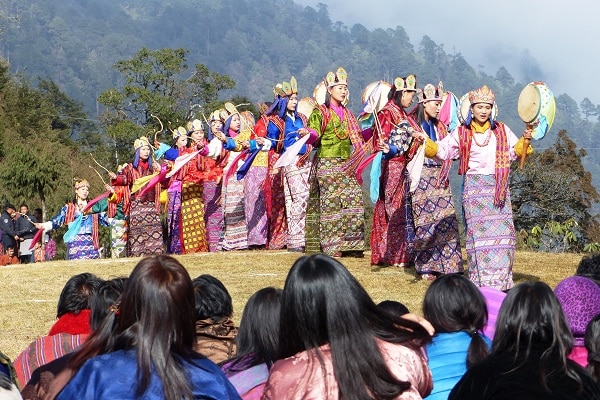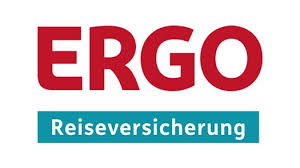From Paro to Bumthang – Experience the festivals and culture of Bhutan
- Description
- Gallery
- Trip itenerary
- Trip dates, prices and services
- Important travel information
- Request Book
On this mystical journey you will witness the country’s famous, colorful and vibrant festivals (tshechus).
These are real cultural spectacles and give you a fascinating insight into the local cultures and customs. Hundreds of people have gathered at these religious festivals for generations to see how the monks in colorful robes perform religious and ritual dances. There are mask dances and prayer meetings for several days, and there is a general carnival atmosphere. It is tradition that everyone must have visited a tshechu and seen mask dances at least once in order to receive the blessing and cleanse themselves of their sins.
In addition to the festivals, you will be impressed by the great monuments of the country, the holy Taksang Monastery (Tiger’s Nest), the Punakha Dzong, Buddha Point and many other important sights and natural wonders of the country.
The Paro Festival and the Punakha Festival take place in the spring, while the Thimpu, Dechenphu or Genekha festivals are held in the fall.
Bhutan is a little hidden paradise waiting to be discovered by you. And who knows, after this trip you might even believe in the myths and stories that are told in the country.
The tour schedule will be adapted to the festivals.
Day 1: Arrival in Kathmandu
You will be picked up at the airport and driven to your hotel. In the afternoon we will discuss the details of the trip with you, and in the evening you are invited to the welcome dinner. Overnight in Hotel Tibet or similar, (D).
Day 2: Kathmandu Sightseeing
Kathmandu has many impressive sights that cannot be done in a day. Our local city guide will show you the three most beautiful and interesting places and sights in the city, the Pashupatinath – a Hindu temple with cremation places, Swayambhunath – also known as the monkey temple and the Boudhanath Stupa. In the afternoon you have time to rest and pack for the onward journey to Bhutan. Overnight in Hotel Tibet or similar, (B).
Day 3: Transfer to Kathmandu Airport for the flight to Paro
Today we fly to Paro. The flight is one of the most spectacular mountain flights in the world and takes you along the highest mountain range on earth. If the weather is clear, we should have a fantastic view of much of the eastern half of the Himalayas and its 8000m peaks Everest, Lhotse, Nuptse, Makalu and Kanchenjunga.
After landing and completing the visa formalities, there is a 20-minute drive to Paro (2,200m) and check in at the hotel.
The Paro Valley is considered to be one of the most beautiful valleys in Bhutan, with blue pine hills and attractive solidly built houses in the middle of rice fields. If the schedule allows, we will visit a museum in the afternoon, the Dzong or Kyichu Lakang, one of the oldest temples in Bhutan, built by the 7th century Tibetan King Songtsen Gampo. Overnight in the hotel, (B|L|D).
Day 4: Paro to Punakha (115km, approx. 3 hours drive) – Dochula Pass and visit to the Mad Man`s Temple
Today we head east to Punakha, which is at 1,240m and has a warmer climate than Paro or Thimpu. The route climbs steadily on a good road to the Dochula Pass. We take a break to marvel at the 108 chortens built on three levels. Up here, at 3,150m, the view over the eastern Himalaya is great, if we don’t have clouds to thwart our plans! The Gangkar Puensum (7,570m) – the world’s highest unclimbed mountain – can also be seen when visibility is good.
In Messina we will stop for lunch. Afterwards a visit to the Mad Man‘s Temple (Chimi Lhakang) is on the agenda. The temple, built in 1499, stands in the middle of the valley on a small hill. It was dedicated to the Lama Drukpa Kunley (1455-1529) – also known as “Divine Madman” – who was known for his humor, his songs and also for his outrageous behavior. Childless couples who pray at this temple are supposed to find happiness afterwards.
The saint also advocated the use of the phallus as a symbol, which is painted on walls and houses to drive away the evil eye. Most of the houses in this area are decorated with ornate phallic paintings.
In the late afternoon we arrive in subtropical Punakha, which was once the capital of Bhutan. We will visit the Dzong, one of the most beautiful in Bhutan and the second one built in 1637. This remarkable fortress lies between the Mo and Po Chhu rivers and has survived many fires, an earthquake and multiple floods. It has been repaired and expanded over the years and has several interesting structural features to protect it from invasions. Overnight in the hotel, (B|L|D).
Day 5: Punakha – Punakha Dzong, participation in the life of the Bhutanese
After breakfast we will drive along the Pho Chu River in Punakha and cross a suspension bridge. After a short, easy walk, we will reach the historic fortress “Punakha Dzong” from the 17th century. This inspiring palace was built by Zhabdrung Ngawang Namgyal in 1637, houses many sacred relics and was the seat of government.
After lunch there are various activities such as archery, helping with field work, learning to cook Bhutan and / or taking a ‘hot stone bath’ (typical type of steam bath). Overnight in the hotel, (B|L|D).
Day 6: Punakha to Trongsa (55 km, 3-4 hours drive)
After breakfast we walk to Khamsum Yulley Namgyal Chorten. This chorten was built to eliminate negative forces and symbolizes peace, stability and harmony in a rapidly changing world. We can enjoy breath-taking views of the valley from the Chorten. Afterwards we drive about 3 hours to Trongsa and then visit the monastery castle Trongsa Dzong. Overnight in a hotel, (B|L|D).
Day 7: Trongsa – Bumthang (75 km, 3-4 hours drive)
Today we continue to Bumthang. The 75-kilometer route takes us over the picturesque Yotong La Pass and down into the Chhume Valley, home of Bhutan’s famous Yatra weaving mills. The afternoon is then at leisure. Overnight at Hotel Ugyen Ling, (B|L|D).
Day 8: Sightseeing in Bhumtang – the land of monasteries and palaces
We start the day exploring the Wangdichhoeling Palace. Afterwards we visit Jambay Lhakhang, one of the oldest monasteries in the country. Then we walk to Kurjey Lhakhang, which is considered Bhutan’s most valuable monument. The early winter festivities are held in Kurjey Lhakhang and thousands of Bhutanese receive their blessings there. From here we hike back to Tamshing Monastery. So today we have lived up to a Bhutanese tradition that says that you should visit these three monasteries in one day. Overnight at Hotel Ugyen Ling, (B|L|D).
Day 9: Bumthang Valley Sightseeing – Tang Valley, Burning Lake
Today’s destination is the beautiful Tang Valley. Before we reach the valley, we will stop at Membar Tsho or Burning Lake. According to tradition, the treasure hunter Terton Pema Lingpa is said to have recovered a treasure from this river in the 15th century. Only a few visitors are out and about in the Tang Valley. Various well-trodden paths lead to Lhakhang with its monasteries and to a museum in the Ogen Chholing Palace. A short hike ends at another well-tended palace, which houses many valuable artifacts. Enjoy a picnic and spectacular views on the way back to Bumthang. Overnight at the Hotel Ugyen Ling, (B|L|D).
Day 10: Bumthang to Gangtey / Phobjikha Valley (170 km and approx. 6 hours drive)
After breakfast we drive to the Phobjikha valley. The highest wetland in the country is located here at 3,000 meters and is used by over 400 black-necked cranes for wintering. The migratory birds coming from Tibet are meanwhile a species threatened with extinction. Overnight at Hotel Dewachen, (B|L|D).
Day 11: Gangtey to Thimphu – astrology school, mini zoo, Buddha Point
We are going to the north of Thimphu. The first stop brings us to the astrology school. Then we continue north to Dodena to visit the mini zoo and observe the national animal “Takine”. We return to Thimphu for lunch. Afternoon free time. Overnight at hotel, (B|L|D).
Day 12: Thimphu Sightseeing and drive to Paro (3 hrs drive)
After breakfast ee undertake an easy hike (about 1.5 hours) through a pine forest to the Wanduetse temple. From here you have a wonderful view of the Thimphu Valley. An equally beautiful view awaits you from the Buddh-Point / Kuenselphodrang (2,600 m). The 52 meter high Buddha statue has become a landmark of Thimphu city in recent years. In the late afternoon we drive back to Paro. Overnight in the hotel, (B|L|D).
Day 13: Paro / Tiger’s Nest
Today we hike up to Tiger’s Nest. The most famous and holiest monastery in Bhutan was recently registered as one of the holiest places in the world. It is enthroned at about 3,100 meters above the Paro valley and is known as the tiger’s nest because the legendary guru Rimpoche allegedly flew to this place on the back of a tigress in the 8th century. The five-hour walk to the monastery is an intense but rewarding mountain tour with an ascent of over 900 meters. It cleanses the soul and the body equally and the sight of the monastery up close is worth the effort. Overnight at Tashi Namgay Resort, (B|L|D).
Day 14: Flight back to Kathmandu – drive to Bhaktapur – Sightseeing
Farewell to your guide and drive to Paro Airport. Flight to Kathmandu. There you will be picked up from the airport and driven to your hotel in Bhaktapur. The medieval city, 17km east of the capital, has its own Durbar Square with many temples and statues and a maze of narrow streets that are generally quieter than Kathmandu. It is worth taking your time for this culturally rich former royal city. Overnight at the Hotel Bhaktapur Heritage House or similar category, (B).
Day 15: Free time until the return flight home, end of the tour
Farewell and transfer to Kathmandu Airport, (B).
We reserve the right to change the program due to special events, force majeure or weather conditions.
B = Breakfast | L = Lunch | D = Dinner
Price and Trip Date
German guided tour
English guided tour
-
02. October 2024 -
16. October 2024
Ugyen Choling Kangsoel4.290 € Request non-bindingBook bindingly
-
13. October 2024 -
27. October 20244.290 € Request non-bindingBook bindingly
-
20. October 2024 -
03. November 20244.290 € Request non-bindingBook bindingly
-
01. November 2024 -
15. November 2024
Jakar Tshechu und Black Necked Crane Festival4.290 € Request non-bindingBook bindingly
-
10. November 2024 -
24. November 20244.290 € Request non-bindingBook bindingly
-
24. November 2024 -
08. December 20244.290 € Request non-bindingBook bindingly
-
06. March 2025 -
20. March 2025
Punakha Tshechu4.290 € Request non-bindingBook bindingly
-
21. March 2025 -
04. April 20254.290 € Request non-bindingBook bindingly
-
31. March 2025 -
14. April 2025
Talo Tshechu in Punakha4.290 € Request non-bindingBook bindingly
-
04. April 2025 -
18. April 2025
Paro Tshechu4.290 € Request non-bindingBook bindingly
-
12. April 2025 -
26. April 20254.290 € Request non-bindingBook bindingly
-
28. April 2025 -
12. May 2025
Domkhar Tshechu in Bumthang4.290 € Request non-bindingBook bindingly
-
16. May 2025 -
30. May 20254.290 € Request non-bindingBook bindingly
-
01. October 2025 -
15. October 2025
Gangtey Tshechu4.290 € Request non-bindingBook bindingly
-
10. October 2025 -
24. October 20254.290 € Request non-bindingBook bindingly
-
20. October 2025 -
03. November 2025
Jakar Tshechu in Bumthang4.290 € Request non-bindingBook bindingly
-
07. November 2025 -
21. November 20254.290 € Request non-bindingBook bindingly
-
14. November 2025 -
28. November 20254.290 € Request non-bindingBook bindingly
Download festivals overview 2024 and 2025
This trekking tour can also be booked for your individual group at an additional cost at dates other than shown here.
Duration: 15 days
Costs : 4.290€ per Person
Group size: min. 2 Persons (all the tour dates are guaranteed with a minimum group size of only two persons)
€ 490 for single room supplement
What’s included:
- Airport transfers in Bhutan and Nepal
- Flight from Kathmandu to Paro – Paro to Kathmandu
- All relevant surface transfer
- All hotel accommodation with breakfast in Nepal
- All meals in Bhutan (B|L|D)
- Sightseeing with entrance fees, guide and vehicle
- Permit, National Park Entrance/Conservation Fees
- Guide & Driver
- Tourist fee per day and person, in Bhutan
- Quality service
Not Included:
- International Flights
- Additional tours and meals that are not mentioned
- Beverages
- Personal bills
- Visa Nepal (approx. US$ 50) and Bhutan (approx. US$ 40)
- Excess baggage charge (beyond 20 Kg each)
- Insurance (for cancellation, accident, health, emergency evacuation and loss, theft of or damage to baggage and personal effects)
- Tips
Visa
Visa fees for Bhutan are included in the price. We will provide the visa applications. Visa fees for Nepal are not included in the price and will be paid in the airport at arrival in Kathmandu (around US$ 50). Two passport size photographs must be provided for the visa. At the time of the trip your passport must be valid for at least a further six months and have at least two blank pages.
These visa and passport regulations apply to EU countries, Switzerland and the USA. Other nationals should check with the relevant consular authorities.
Vaccinations
There are no vaccinations required for traveling to Bhutan at this time. However, you should be vaccinated against COVID-19, tetanus, hepatitis A and diphtheria. We recommend you consult your GP (general practitioner) in good time, about three months before your trip.
Insurance
We highly recommend the conclusion of travel cancellation insurance. In the case of bargain price flights in particular, changes or cancellations generally can’t be made free of charge.
We have requested ERGO (Reiseversicherung) to create various service packages for you. You can book travel cancellation insurance at www.reiseversicherung.de.
Please note: ERGO insurance can be booked by residents of Germany and Austria. Those living in other countries are requested to book their travel insurance through an insurance provider in their own country.
It should be noted that geoDiscovery Tours advises its customers to book their travel insurance via ERGO as a recommendation only, and accepts no responsibility for the contractual content between the customer and the travel insurance provider. Customers can book their travel insurance via ERGO or another provider at their own discretion.
Flying in Bhutan and Nepal
The flights booked by us, between Nepal and Bhutan are with Bhutan Air or Druk Air. The domestic flights in Nepal booked by us are with Tara Air, Yeti Air, Sita Air, Summit Air or Buddha.
The hotels and lodges booked by us
In Nepal and Bhutan the hotels we book are good and correspond to medium-level Western standards. Sanitary facilities are clean and functional; the hotel cuisine is adapted to Western eating habits and the food is safe to enjoy. In Nepal, there may sometimes be power cuts or no hot water available for a while. The hotel staff is generally very friendly and looks after the welfare of guests. The hotels booked by us are as follows:
In Bhutan
Thimphu: Hotel Phuntsho Pelri
Phobikha: Hotel Dewachen
Bumthang: Hotel Ugyen Ling
Punakha: Meri Puensum Resort
Paro: Tashi Namgay Resort
In Nepal
Kathmandu: Hotel Tibet/Manaslu ***+
Pokhara: Mount Kailash Resort, Lake side retreat ***
Lumbini: Hotel New Crystal ***
Chitwan: Jungle Villa Resort
Nagarkot: Nagarkot Farmhouse
Tour program
The travel program for all of our recommended tours is carefully planned. It can happen, however, that roads are closed without advance notice or are impassable, that there are waiting times of several hours because of traffic congestion or fuel shortages and that specific tourist attractions are closed for various reasons. Other restrictions such as flight delays or even cancellations due to bad weather, strikes or the health of participants may also make the implementation of the travel program more difficult or at worst make it impossible. However, our local guides are prepared for such situations and will make every effort to achieve every aspect of the program to your satisfaction. As a result the inconvenience can normally be kept to a reasonable level. Nevertheless, it must be pointed out at this juncture that for the above reasons program changes are possible at any time and cannot be influenced by the organizers. The resulting costs are borne by the traveler. We ask for your understanding.
Road Situation
Despite high mountains, steep slopes, and the deepest of valleys Bhutan has a relatively well developed network of roads. It is difficult to find a length of either straight or flat road. In some stretches one can encounter 6 to 7 bends per kilometer! Steep ascents and descents are characteristic of road travel in Bhutan and this can make traveling much slower than one may be used to. The average driving speed is 40 km per hour. Travelers need to be adaptable, however.
Trip Details
- Duration: 15 days
- Holiday Type: Hotel Accommodation
- Best trekking period: Oct/Nov/Dec/Feb/Mar/Apr/May
- Difficulty: Gentle
- Max Altitude: 3.500 m
- Group size: Min. 2 persons (all the tour dates are guaranteed with a minimum group size of only two persons)
- Tour guide: English speaking, trained Bhutanese guide
-
Difficulty:
-
Fitness:
- Price: 4.290,00 €
- Single room supplement: 490,00 €


 Bhutan
Bhutan 



















































